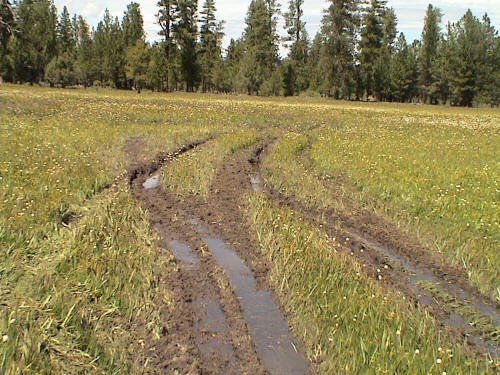 ™
™TRADITIONAL MOUNTAINEERING
™
www.TraditionalMountaineering.org
™ and also
www.AlpineMountaineering.org
™
 ™
™
FREE BASIC TO ADVANCED
ALPINE MOUNTAIN CLIMBING INSTRUCTION™
Home
| Information
| Photos
| Calendar
| News
| Seminars
| Experiences
| Questions
| Updates
| Books
| Conditions
| Links
| Search
![]()

FOREST SERVICE RELEASES
DRAFT POLICY
ON OFF-HIGHWAY VEHICLE USE IN NATIONAL FORESTS AND GRASSLANDS
WASHINGTON, July 7, 2004 – U.S. Department of Agriculture Forest Service
today released its proposal for managing motorized off-highway vehicle (OHV)
use in national forests and grasslands, which will enhance recreational
opportunities for the public and better protect the environment by requiring
units to establish a designated system of roads, trails and areas.
Public comments are now being accepted for the national proposed rule. Local
planning and public participation in Central Oregon will begin in late 2004
or early 2005.
“OHVs are a great way to experience the national forests, but because their
popularity has increased in recent years, we need an approach that will
sustain natural resource values through more effective management of motor
vehicle use. The benefits of improving OHV use include enhanced protection
of habitat and aquatic, soil, air and cultural resources,” said Forest
Service Chief Dale Bosworth. “The Forest Service wants to improve its
management by balancing the public’s enjoyment of using OHVs with ensuring
the best possible care of the land.”
In 2002, national forests and grasslands had more than 214 million visits.
Nationally, the number of OHV users climbed sevenfold in the last 30
years--from five million in 1972 to 36 million in 2000. OHV users account
for about 1.8 million or five percent of visitors to national forests and
grasslands. Currently each of the 155 national forests and 21 grasslands has
guidelines regarding OHV use, with some national forests managing use on a
designated system of roads, trails and areas, while other do not. As a
result, the Forest Service does not have a clear, consistent policy
regarding motor vehicle use on national forests and grasslands.
The proposed rule represents a nationally consistent approach to travel
management by requiring each forest and grassland to designate a system of
roads, trails and areas slated for motor vehicle use. It would allow
national forests to denote use of routes and areas by vehicle type and, if
appropriate, by time of year. Once the designation process is complete, OHV
use would be confined to designated routes and areas, and OHV use off these
routes (cross-country travel) would be prohibited. Snowmobile use would
continue to be managed as it is currently—allowed, restricted or prohibited
on roads and trails and in areas on National Forest System lands.
“While some forests have begun to designate roads, trails, and areas for
OHVs, I expect units to make significant progress in improving management of
OHVs in the next two years,” said Bosworth. “We want to improve our
management of outdoor recreation by having a system of routes and areas
offering the best opportunities for OHV use
while still meeting our responsibility to sustain National Forest System
lands and resources.”
The proposed rule calls for the Forest Service to continue to engage with
motorized sports enthusiasts, conservationists, state agencies, local
governments, tribal governments, and others to identify routes offering the
best opportunities for OHV use while still meeting its responsibility to
protect the environment. The public would continue to be allowed to
participate in the process of designating roads, trails, and areas or
revising designations and would continue to receive advance notice to allow
for
public comment on proposed or revised designations. The agency has partnered
with these groups in the past to provide enhanced motorized recreation
opportunities by constructing, marking, maintaining and restoring trails as
well as by providing training and safety instruction to users.
OHVs include motor vehicles that are designed or retrofitted primarily for
recreational use off road, such as mini-bikes, amphibious vehicles,
snowmobiles, motorcycles, go-carts, motorized trail bikes, and dune buggies.
The agency is accepting comments for 60 days after the proposal is published
in the Federal Register. The rule text submitted to the Office of the
Federal Register is available on http://www.fs.fed.us/.
Written comments may be sent to:
Proposed Rule for Designated Routes and Areas for Motor Vehicle Use
c/o Content Analysis Team
P.O. Box 221150
Salt Lake City, Utah 84122-1150
Comments also will be accepted by electronic mail to trvman@fs.fed.us or by
facsimile to 801-517-1014.
Comments also may be submitted by following the instructions at the federal
eRulemaking portal at http://www.regulations.gov. All comments will be
analyzed and
addressed in promulgation of a final rule.
Map of huge exclusive OHV areas adjoining the
Badlands
![]()
Read more . . .
The
Badlands Wilderness
BLM posts Reward for information on
Juniper rustlers
BLM weighing public input on management plan
Oregon's Badlands hit by old growth Juniper rustlers
Photos
Congressman Greg Walden to visit The Badlands
Badlands Wilderness endorsed by COTA
OpEd
- Unregulated OHV use is being reviewed across the western states
OHV use curtailed by new USFS policy decisions
Sierra Club's Juniper Group
supports Badlands Wilderness
OHV regulation discussed at BLM meeting in Bend, Oregon
OpEd - Badlands part of
BLM's recreation management area
OpEd - We need the Badlands Wilderness
OpEd - Off-roaders have no reason to fear Badlands Wilderness designation
Speak for the Badlands at Town Hall Meeting
Hiking poles are becoming essential gear
Vandals destroy ancient
pictographs in the Badlands
Senator
Wyden tests support of Badlands Wilderness
Badlands Wilderness endorsed by Bend City
Commissioners
The Badlands:
proposed for Wilderness status
The
Badlands, a brief history
The Badlands
pictographs
reported 75 year ago![]()